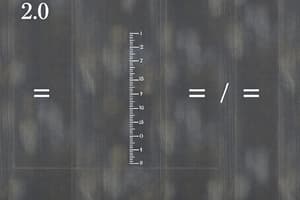Podcast
Questions and Answers
What is the structure of a number in standard form?
What is the structure of a number in standard form?
The structure is written as $a \times 10^n$, where $1 \leq a < 10$ and $n$ is an integer.
In dividing numbers in standard form, what do you do with the exponents?
In dividing numbers in standard form, what do you do with the exponents?
You subtract the exponent of the divisor from the exponent of the dividend.
Given $6 \times 10^3$ divided by $3 \times 10^1$, what is the result when converted to standard form?
Given $6 \times 10^3$ divided by $3 \times 10^1$, what is the result when converted to standard form?
The result is $2 \times 10^2$.
When multiplying in standard form, what is done with the coefficients?
When multiplying in standard form, what is done with the coefficients?
If you multiply $2 \times 10^2$ by $5 \times 10^3$, what is the result before adjustment?
If you multiply $2 \times 10^2$ by $5 \times 10^3$, what is the result before adjustment?
What must you do if the coefficient in the multiplication result exceeds 10?
What must you do if the coefficient in the multiplication result exceeds 10?
What is the adjusted form of $10 \times 10^5$?
What is the adjusted form of $10 \times 10^5$?
What steps are involved in dividing numbers written in standard form?
What steps are involved in dividing numbers written in standard form?
What is the rule for the coefficients in standard form?
What is the rule for the coefficients in standard form?
When dividing the numbers in standard form, which operation is performed first?
When dividing the numbers in standard form, which operation is performed first?
What is the combined result of dividing (8.5 × 10^4) by (1.7 × 10^2) in standard form?
What is the combined result of dividing (8.5 × 10^4) by (1.7 × 10^2) in standard form?
If you multiply (7.2 × 10^1) by (2.5 × 10^2), what is the proper way to express the result in standard form?
If you multiply (7.2 × 10^1) by (2.5 × 10^2), what is the proper way to express the result in standard form?
What should be done after multiplying the coefficients in standard form?
What should be done after multiplying the coefficients in standard form?
What is the exponent adjustment needed when you multiply (3.6 × 10^3) by (4.0 × 10^2) and get 14.4?
What is the exponent adjustment needed when you multiply (3.6 × 10^3) by (4.0 × 10^2) and get 14.4?
What final result do you obtain when dividing (5.0 × 10^5) by (2.5 × 10^3)?
What final result do you obtain when dividing (5.0 × 10^5) by (2.5 × 10^3)?
Which step is NOT part of the process when multiplying in standard form?
Which step is NOT part of the process when multiplying in standard form?
Study Notes
Dividing In Standard Form
-
Standard Form Structure: Written as ( a \times 10^n ), where:
- ( 1 \leq a < 10 )
- ( n ) is an integer
-
Steps for Division:
- Divide the coefficients: Divide ( a_1 ) by ( a_2 ).
- Subtract the exponents: For the powers of ten, subtract the exponent of the divisor from the exponent of the dividend:
- If ( a_1 \times 10^{n_1} \div a_2 \times 10^{n_2} ), then:
- Result = ( \frac{a_1}{a_2} \times 10^{n_1 - n_2} )
- Adjust to standard form: If the coefficient is not between 1 and 10, adjust it accordingly.
-
Example:
- Divide ( 6 \times 10^3 ) by ( 3 \times 10^1 ):
- Coefficient: ( \frac{6}{3} = 2 )
- Exponents: ( 3 - 1 = 2 )
- Result: ( 2 \times 10^2 )
- Divide ( 6 \times 10^3 ) by ( 3 \times 10^1 ):
Multiplying In Standard Form
-
Steps for Multiplication:
- Multiply the coefficients: Multiply ( a_1 ) by ( a_2 ).
- Add the exponents: For the powers of ten:
- If ( a_1 \times 10^{n_1} \times a_2 \times 10^{n_2} ), then:
- Result = ( (a_1 \times a_2) \times 10^{n_1 + n_2} )
- Adjust to standard form: If the coefficient exceeds 10 or is less than 1, adjust to standard form.
-
Example:
- Multiply ( 2 \times 10^2 ) by ( 5 \times 10^3 ):
- Coefficient: ( 2 \times 5 = 10 ) (needs adjustment)
- Exponents: ( 2 + 3 = 5 )
- Adjusted Result: ( 1 \times 10^{5} ) (where ( 10 = 1 \times 10^1 ), hence ( 1 \times 10^{6} ))
- Multiply ( 2 \times 10^2 ) by ( 5 \times 10^3 ):
Standard Form Structure
- Standard form is written as ( a \times 10^n ) where ( a ) is between 1 and 10 (inclusive) and ( n ) is an integer.
Dividing Numbers in Standard Form
- To divide numbers in standard form, divide the coefficients and subtract the exponents of the powers of ten.
- The standard form result can be achieved when ( \frac{a_1}{a_2} ) is adjusted to be between 1 and 10.
Multiplying Numbers in Standard Form
- To multiply numbers in standard form, multiply the coefficients and add the exponents of the powers of ten.
- The standard form result can be achieved when ( a_1 \times a_2 ) is adjusted to be between 1 and 10.
Standard Form
- Standard form expresses numbers as a × 10^n, where 1 ≤ a < 10 and n is an integer.
- The coefficient (a) is a number between 1 and 10 (not including 10).
- The exponent (n) is an integer.
Dividing in Standard Form
- To divide numbers in standard form, follow these steps:
- Divide the coefficients.
- Subtract the exponents.
- Combine the results in standard form.
Multiplying in Standard Form
- To multiply numbers in standard form, follow these steps:
- Multiply the coefficients.
- Add the exponents.
- Combine the results in standard form.
- Adjust the coefficient and exponent of the result to ensure the coefficient is between 1 and 10.
Studying That Suits You
Use AI to generate personalized quizzes and flashcards to suit your learning preferences.
Description
This quiz covers the essential steps for dividing and multiplying numbers in standard form. It includes the structure of standard form, detailed steps for both operations, and examples to illustrate the process. Test your understanding of how to handle coefficients and exponents effectively.




